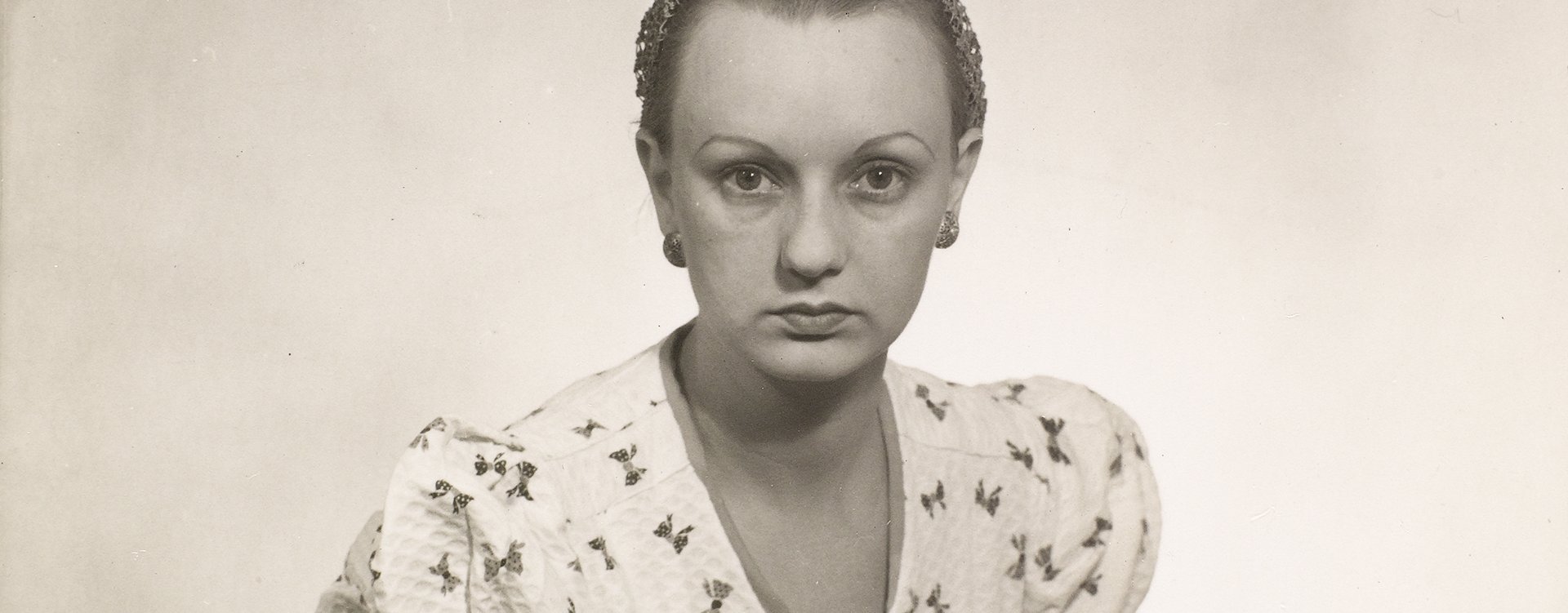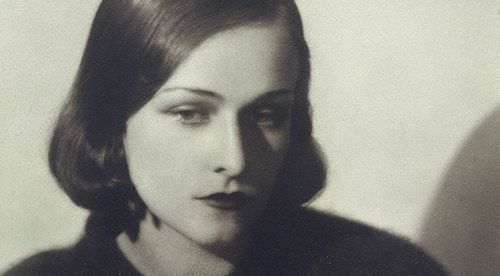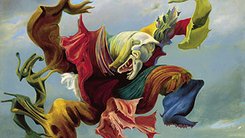
Ithell Colquhoun, High Priestess of British Surrealism
In 1981, Ithell Colquhoun penned a letter to the editors of The Oxford Journal: "Breton said somewhere – I quote from memory, ‘que la femme soit libre et adorée’. But I’m sorry to say that […] most of Breton’s followers were no less chauvinist for all that. Among them, women as human beings tended to be ‘permitted not required’."
Breton said somewhere – I quote from memory, ‘que la femme soit libre et adorée’. But I’m sorry to say that […] most of Breton’s followers were no less chauvinist for all that. Among them, women as human beings tended to be ‘permitted not required’."
Ithell Colquhoun, The Oxford Journal, 1981
Colquhoun (1906 – 1988) was a pioneering figure in the British Surrealist movement, renowned for her work as an occult artist, writer, and theorist. Over her seven-decade career, she explored themes deeply influenced by her spiritual journey, crafting art that seamlessly navigated between the realms of the esoteric and surreal. Her contributions, once overshadowed, are now receiving renewed scholarly and public attention. This resurgence, driven by scholars like Amy Hale and Richard Shillitoe, and bolstered by the Tate Gallery's acquisition of her archives and artworks in 2019, has sparked a thorough re-evaluation of her legacy. As the art world revisits her contributions with fresh eyes, Colquhoun’s visionary integration of mysticism and Surrealism continues to inspire new generations, affirming her place as a transformative force in both fields.
In collaboration with Art Basel Paris
Early Life and Artistic Influences
Born in Assam, northern India, in 1906, to a family with Colonial Indian heritage, Colquhoun moved to England at the age of one. Demonstrating an aptitude for art, her early notebooks were filled with finely detailed and delicate drawings of fairies, elves, goblins and botanical subjects. "My first painting” she later recalled “was an oval rose on a triple stem, with a bud on each side; my second was a purple sun with orange rays setting behind a green slope." After studying for two years at Cheltenham School of Art, Colquhoun enrolled in 1928 at the Slade School of Fine Art, London, one of England's most progressive and prestigious art institutions.
In 1931 she encountered Surrealism for the first time and met several prominent Surrealists, including René Magritte, André Breton, Salvador Dalí, Marcel Duchamp, and Man Ray - who famously photographed her holding a sheaf of wheat, evoking Demeter, the ancient goddess of the harvest, fertility and the earth.
To further her training, Ithell Colquhoun, like many British artists, travelled to Paris where she attended the Académie Colarossi in 1931. During this period, she encountered Surrealism for the first time and met several prominent Surrealists, including René Magritte, André Breton, Salvador Dalí, Marcel Duchamp, and Man Ray - who famously photographed her holding a sheaf of wheat, evoking Demeter, the ancient goddess of the harvest, fertility and the earth.
After a transformative two-year immersion in the vibrant Parisian art scene, Colquhoun returned to London. The influence of Surrealism was evident in her first solo exhibition at Cheltenham Art Gallery in 1936, where she reinterpreted plant studies as still-life compositions imbued with erotic symbolism. Her visit to the International Surrealist Exhibition at London's Burlington Galleries that same year, and particularly her exposure to the work of Salvador Dalí, further intensified the impact of Surrealism on her work.
In 1939, Colquhoun firmly aligned herself with Surrealism, and in a moment of significant recognition, she was invited to join the British Surrealist Group under the direction of the Belgian art dealer and artist E. L. T. Mesen's. This affiliation opened new avenues for her work, and by June of that year she was featured in a joint exhibition at the Mayor Gallery, a major commercial venue for Surrealism in London, where she exhibited alongside Roland Penrose. This event marked a milestone in her career.
In the summer of 1939, following the success of her exhibition, Colquhoun returned to Paris where among other catalytic encounters she visited Jacqueline Lamba and André Breton at their studio on Rue Fontaine. During this visit, in what proved to be an epiphany, she was introduced to the concept of automatism and in particular the notion of 'psycho-morphology',
In the summer of 1939, following the success of her exhibition, Colquhoun returned to Paris where among other catalytic encounters she visited Jacqueline Lamba and André Breton at their studio on Rue Fontaine. She would later recall the studio as a realm of exotic wonder, its walls adorned with surrealist masterpieces and cases of tropical butterflies. During this visit, in what proved to be an epiphany, she was introduced to the concept of automatism and in particular the notion of 'psycho-morphology', a method of uncovering and expressing the hidden contents of the psyche through automatic processes and diverse media, described by Breton as ‘fusion and germination, balances and departures’.
In 1940, Colquhoun’s seemingly peripatetic career encountered a dramatic setback when, during a notorious gathering at the Barcelona Restaurant in Soho, London, Mesens expelled her along with fellow female Surrealists, Grace Pailthorpe, Ruth Adams and Eileen Agar (the latter being the only one later reinstated) from the British Surrealist Group. Colquhoun’s exclusion was primarily due to her steadfast refusal to relinquish her interest in the occult. Consequently, the 1940s proved a bleak era for the artist, as opportunities for exhibiting and publishing her work dwindled.
In 1943, Colquhoun married the Russian-born Surrealist artist and poet, Toni Del Renzio. During their brief union, they actively promoted Surrealism in Britain through exhibitions, such as the 1942 show at the International Arts Centre (IAC), London, featuring work by Agar, Colquhoun and others.
Gender and Identity in Colquhoun’s Work
At the heart of the Surrealist movement, women occupied an ambiguous reality. Although promised liberation from oppressive norms, they frequently found themselves ensnared in a dreamscape shaped by traditional male desires. Revered yet feared, objectified and demeaned, women were often cast in archetypal roles such as femme enfant, celestial beings, muses, sorceresses, erotic objects, and femme fatale. Celebrated in poems, stories, paintings, and photographs, they embodied what Breton described as a “conducteur merveilleusement magnétique”—the ultimate source of male inspiration. Agar noted the irony that, despite Lamba’s ‘considerable ability’, Breton ‘never mentioned her work’.
At the heart of the Surrealist movement, women occupied an ambiguous reality. Although promised liberation from oppressive norms, women frequently found themselves ensnared in a dreamscape shaped by traditional male desires. Revered yet feared, objectified and demeaned, women were often cast in archetypal roles such as femme enfant, celestial beings, muses, sorceresses, erotic objects, and femme fatale.
As part of this perception, when the art of women Surrealists was assessed, it was often through the lens of enduring stereotypes. In a 1946 article titled “To the Ladies” for the Saturday Review of Literature, critic James Thrall Soby argued that surrealism was particularly well-suited to women artists, but only on account of their supposed tendency towards "an unrelenting and naked introspection." Peggy Guggenheim’s 1943 exhibition "31 Women" at the Art of This Century Gallery in New York, which featured prominent women surrealists such as Leonora Carrington, faced similar criticism.
Alongside other pioneering women surrealists, including Carrington, Edith Rimmington and Agar, Colquhoun sought to redefine female identity through rich and symbolic archetypes: the Goddess, the Alchemist, the Scientist, the Weaver of destinies, the Spiritual Guide and, most resolutely, the Great Mother Goddess. She explored her own sexuality and identity through her artwork. Her renowned masterpiece Scylla (1938, Tate Gallery), inspired by her own reflections in a bath, blends seascape and self-portrait: the rock formations echo her knees, while the seaweed alludes to her pubic hair. The title references the Greek monster, Scylla, who thrived by devouring sailors.
Exploring the Esoteric
Colquhoun’s spiritual quest encompassed a wide range of esoteric traditions, including alchemy, magic, Rosicrucianism, Kabbalah, Gnosticism, Tarot, astrology, Theosophy, Christian mysticism, and Celtic lore. This profound engagement with the occult, which began at the Slade when she immersed herself in mystical circles like the Quest Society, infused her artwork, poetry, and essays with arcane significance. By the 1950s, Colquhoun’s associations extended to Aleister Crowley’s Ordo Templi Orientis and Kenneth Grant’s New Isis Lodge. The 1960s saw her involvement with the Druid Order, the Ancient Celtic Church, and various Masonic lodges, culminating in her ordination as a Priestess of Isis by the Fellowship of Isis in 1977.
Colquhoun explored her own sexuality and identity through her artwork. Her renowned masterpiece Scylla, inspired by her own reflections in a bath, blends seascape and self-portrait: the rock formations echo her knees, while the seaweed alludes to her pubic hair. The title references the Greek monster, Scylla, who thrived by devouring sailors.
Life in Cornwall
In her later years, Colquhoun's art increasingly reflected her deepening engagement with esoteric traditions, blending mystical and occult elements with themes of feminine power and spiritual exploration. Following her separation from del Renzio, and growing sense of estrangement from artistic mainstream, she relocated in 1958 to the remote village of Paul in the far west of Cornwall, where she remained for the rest of her life. This region, steeped in mysticism with its ancient wells, crosses, and stone circles, had long held a special place in her heart. She devoted her time to painting, Celtic history and writing novels and poems, topographical books, and short stories.
During her lifetime and subsequently, Colquhoun's profound spirituality and esoteric explorations have tended to be underplayed. Yet, as contemporary art history increasingly values the intersection of spirituality and artistic expression (for example, in the work of Hilma af Klimt and Georgina Houghton), Colquhoun’s work is being understood in a new light. Furthermore, the rigorous re-evaluation of historic attitudes towards women artists is elevating Colquhoun from the position of a marginal figure to a high priestess of the Surrealist movement. Her unique vision is receiving renewed acclaim, as international exhibitions, such as « Surrealisme » at the Pompidou Centre, reintegrate her work into the core narrative of what is arguably the most significant artistic movement of the 20th century. A major touring retrospective, debuting at Tate St Ives next February before moving to London in June, represents a further significant moment in the re-evaluation of her legacy. ◼
Related articles
In the calendar
Man Ray (Emmanuel Radnitzky, dit), portrait d'Ithell Colquhoun, vers 1932 (détail)
Epreuve gélatino-argentique, 11,1 x 8,1 cm
© Man Ray Trust / Adagp, Paris
Centre Pompidou, Mnam-Cci /Dist. Rmn-Gp





